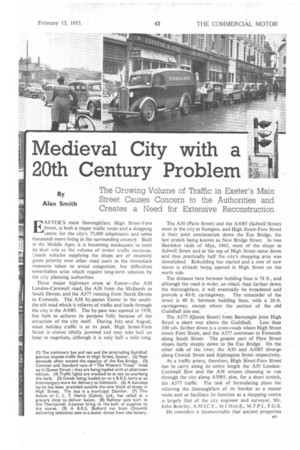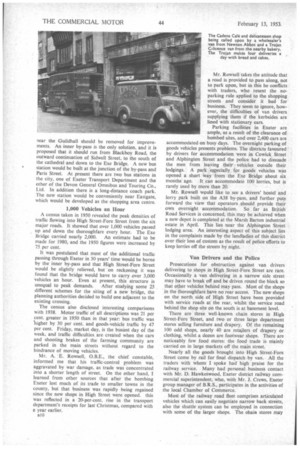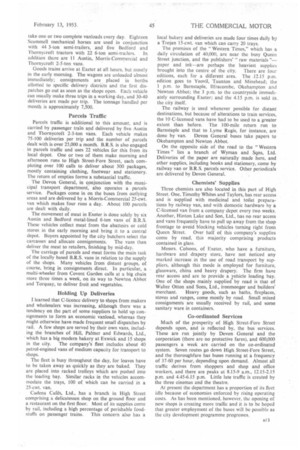Medieval City with a 20th Century Problem
Page 43

Page 44

Page 47

If you've noticed an error in this article please click here to report it so we can fix it.
The Growing Volume of Traffic in Exeter's Main Street Causes Concern to the Authorities and Creates a Need for Extensive Reconstruction
By Alan Smith
EKETER'S main thoroughfare. High Street-Fore Street, is both a major traffic route and a shopping ,-entre for the city's 75,000 inhabitants and some thousands more living in the surrounding country. Built in the Middle Ages, it is becoming inadequate to meet its dual role as the volume of' motor traffic increases. '3oods vehicles supplying the shops are of necessity given priority over other road users in the immediate measures taken to avoid congestion, but difficulties nevertheless arise which require long-term solution by the city planning authorities.
Three major highways cross at Exeter—the A30 London-Cornwall road, the A38 from the Midlands to South Devon, and the A377 running from North Devon to Exmouth. The A38 by-passes Exeter to the southE the old road which it relieves of traffic and leads through the city is the A3085. The by-pass was opened in 1938, but fails to achieve its purpose fully because of the attraction of the city itself. During July and August, when holiday traffic is at its peak, High Street-Fore Street is almost tdtally jammed and may take half an hour to negotiate, although it is only half a mile long. The A30 (Paris Street) and the A3085 (Sidwell Street) meet in the city at Eastgate, and High Street-Fore Street is their joint continuation down the Exe Bridge, the last stretch being known as New Bridge Street. In two Baedeker raids of May, 1942, most of the shops in Sidweil Street and at the top of High Street came down and thus practically half the city's shopping area was demolished. Rebuilding has started and a row of new stores is already being opened in High Street on the north side.
The distance here between building lines is 74 ft., and although the road is wider, as relaid, than farther down the thoroughfare, it will eventually be broadened and provide a 40-ft. carriageway. The remainder of the street is 40 ft. between building lines, with a 26-ft. carriageway, except where the portico of the old Guildhall juts out.
The A377 (Queen Street) from Barnstaple joins High Street a short way above the Guildhall. Less than 100 yds. farther down is a cross-roads where High Street meets Fore Street, and the A377 continues to Exmouth along South Street. The greater part of Fore Street slopes fairly steeply down to the Exe Bridge. On the other side of the river, the A30 and A3085 diverge along Cowick Street and Alphington Street respectively.
As a traffic artery, therefore, High Street-Fore Street has to carry along its entire length the A30 LondonCornwall flow and the A38 stream choosing to run through the city along A3085, plus, for a short stretch, the A377 traffic. The task of formulating plans for relieving the thoroughfare of its burden as a motor route and so facilitate its function as a shopping centre is largely that of the city engineer and surveyor, Mr. John BrierIey, A.M.I.C.E., M.I.Mun.E., M.T.P.1., F.G.S.
tie considers it inconceivable that ancient properties
near the Guildhall should be removed for improvements. An inner by-pass is the only solution, and it is proposed that it should run from Blackboy Road, the outward continuation of Sidwell Street, to the south of the cathedral and down to the Exe Bridge. A new bus station would be built at the junction of the by-pass and Paris Street. At present there are two bus stations in the city, one of Exeter Transport Department and the other of the Devon General Omnibus and Touring Co., Ltd. In addition there is a long-distance coach park. The new station would be conveniently near Eastgate, which would be developed as the shopping area centre.
1,000 Vehicles an Hour
A census taken in 1950 revealed the peak densities of traffic flowing into High Street-Fore Street from the six major roads. It showed that over 1,000 vehicles passed up and down the thoroughfare every hour. The Exe Bridge carried nearly 2,000. An estimate had to be made for 1980, and the 1950 figures were increased by 75 per cent.
It was postulated that most of the additional traffic passing through Exeter in 30 years' time would be borne by the inner by-pass and that High Street-Fore Street would be slightly relieved, but on reckoning it was found that the bridge would have to carry over 3,000 vehicles an hour. Even at present, this structure is unequal to peak demands. After studying some 25 different schemes for the siting of a new bridge, the planning authorities decided to build one adjacent to the existing crossing.
The census also disclosed interesting comparisons with 1938. Motor traffic of all descriptions was 21 per cent, greater in 1950 than in that year: bus traffic was 'higher by 30 per cent, and goods-vehicle traffic by 47 per cent. Friday, market day, is the busiest day of the week, and traffic difficulties are created when the cars and shooting brakes of the farming community are parked in the main streets without regard to the hindrance of moving vehicles.
Mr. A. E. Rowsell, 0.B.E., the chief constable, informed me that his traffic-control problem was aggravated by war damage, as trade was concentrated into a shorter length of street. On the other hand, I learned from other sources that after the bombing Exeter lost much of its trade to smaller towns in the county, but that business was rapidly being regained since the new shops in High Street were opened. this was reflected in a 20-per-cent. rise in the transport department's receipts for last Christmas, compared with a year earlier.
st 0 Mr. Rowsell takes the attitude that a road is provided to pass along, not to park upon, but in this he conflicts with traders, who resent the nopark ing rule applied to the shopping streets and consider it bad for business. They seem to ignore, however, the difficulties of van drivers supplying them if the kerbsides are lined with stationary cars.
Parking facilities in Exeter are ample, as a result of the clearance of bombed sites, and over 2,400 cars are accommodated on busy days. The overnight parking of goods vehicles presents problems. The districts favoured by drivers for accommodation were in Cowick Street and Alphington Street and the police had to dissuade the men from leaving their vehicles outside their lodgings. A park especially for goods vehicles was opened a short way from the Exe Bridge about six months ago. It can accommodate 100 lorries, but is rarely used by more than 20.
Mr. Rowsell would like to see a drivers' hostel and lorry park built on the A38 by-pass, and further puts forward the view that operators should provide their own overnight accommodation. So far as British Road Services is concerned, this may be achieved when a new depot is completed at the Marsh Barton industrial estate in April. This lies near the Alphington Street lodging area. An interesting aspect of this subject lies in the complaints made by the landladies of this district over their loss of custom as the result of police efforts to keep lorries off the streets by night.
Van Drivers and the Police
Prosecutions for obstruction against van drivers delivering to shops in High Street-Fore Street are rare. Occasionally a van delivering in a narrow side street may have to break off and be driven round the block so that other vehicles behind may pass. Most of the shops in the thoroughfare have no rear access. The new shops on the north side of High Street have been provided with service roads at the rear, whilst the service road behind the shop site on the south is at basement level.
There are three well-known chain stores in High Street-Fore Street, and two or three large department stores selling furniture and drapery. Of the remaining 100 odd shops, nearly 40 are retajlers of drapery or clothing, whilst a dozen are footwear shops. There are noticeably few food stores: the food trade is mainly carried on in large markets off the main street.
Nearly all the goods brought into High Street-Fore Street come by rail for final dispatch by van. All the traders with whom I spoke had high praise for the railway service. Many had personal business contact with Mr. D. Hawkeswood, Exeter district railway commercial superintendent, who, with Mr. L Crews, Exeter group manager of B.R.S., participates in the activities of the local Chamber of Commerce.
Most of the railway road fleet comprises articulated vehicles which can easily negotiate narrow back streets, also the shuttle system can be employed in connection with some of the larger shops. The cliaiR stores may take one or two complete vanloads every day. Eighteen Scammell mechanical horses are used in conjunction with 44 3-ton semi-trailers, and five Bedford and Thornycroft tractors with 22 6-ton semi-trailers. In addition there are 11 Austin, Morris-Cornmercial and Thornycroft 2-5-ton vans.
Goods trains arrive at Exeter at all hours, but mostly in the early morning. The wagons are unloaded almost immediately; consignments are placed in berths allotted to specific delivery districts and the first dispatches go out as soon as the shops open. Each vehicle can usually make three trips in a working day, and 30-40 deliveries are made per trip. The tonnage handled per month is approximately 7,500.
Parcels Traffic Parcels traffic is additional to this amount, and is carried by passenger train and delivered by five Austin and Thornycroft 2-3-ton vans. Each vehicle makes 75-100 deliveries per trip and the number of parcels dealt with is over 25,000 a month. B.R.S. is also engaged in parcels traffic and uses 22 vehicles for this from its local depot. One or two of them make morning and afternoon runs to High Street-Fore Street, each completing over 100 calls to deliver about 300 packages, mostly containing clothing, footwear and stationery. The return of empties forms a substantial traffic.
The Devon General, in conjunction with the municipal transport department, also operates a parcels service. Packages come in on the buses from outlying areas and are delivered by a Morris-Commercial 25-cwt. van which makes four runs a day. About 100 parcels are dealt with daily.
The movement of meat in Exeter is done solely by six Austin and Bedford metal-lined 6-ton vans of B.R.S. These vehicles collect meat from the abattoirs or cold stores in the early morning and bring it to a central depot. Buyers appointed by the city butchers select the carcasses and allocate consignments. The vans then deliver the meat to retailers, finishing by mid-day.
The carriage of parcels and meat forms the main task of the locally based B.R.S. vans in relation to the supply of the shops. Many vehicles from distant groups, of course, bring in consignments direct. In particular, a multi-wheeler from Covent Garden calls at a big chain store three times a week, on its way to Newton Abbot and Torquay, to deliver fruit and vegetables.
Holding Up Deliveries I learned that C-licence delivery to shops from makers and wholesalers was increasing, although there was a tendency on the part of some suppliers to hold up consignments to form an economic vanload, whereas they might otherwise have made frequent small dispatches by rail. A few shops are served by their own vans, including the branches of Hill, Palmer and Edwards, Ltd., 'which has a big modern bakery at Exwick and 15 shops in the city. The company's fleet includes about 40 petrol-engined vans of medium capacity for transport to shops.
The fleet is busy throughout the day, for loaves have to be taken away as quickly as they are baked. They are placed into racked trolleys which are pushed into the loading bay. Similar racks in the vehicles accommodate the trays, 100 of which can be carried in a 25-cwt. van.
Cadena Cafes, Ltd., has a branch in High Street comprising a delicatessen shop on the ground floor and a restaurant on the first floor. Most of its supplies come by rail, including a high percentage of perishable food stuffs on passenger trains. This concern also has a local bakery and deliveries are made four times daily by a Trojan 15-cwt. van which can carry 20 trays.
The premises of the "Western Times," which has a daily circulation of 40,000, are near the busy Queen Street junction, and the publishers' " raw materials "paper and ink—are perhaps the heaviest supplies
brought into the centre of the city. There are four editions, each for a different area. The .12.15 p.m. edition goes to Yeovil, Taunton and Minehead; the 1 p.m. to Barnstaple, Ilfracombe, Okehampton and Newton Abbot; the 3 p.m. to the countryside immediately surrounding Exeter; and the 4.15 p.m. is sold in. the city itself.
The railway is used whenever possible for distant destinations, but because of alterations to train services, the 10 C-licensed vans have had to be used to a greater extent than before. The 100-mile return run to Barnstaple and that to Lyme Regis, for instance, are done by van. Devon General buses take papers to Okehampton and Newton Abbot.
On the opposite side of the road to the 'Western Times" lies a branch of Wyman and Sqns, Ltd. Deliveries of the paper are naturally made here, and other supplies, including books and stationery, come by railway van or B.R.S. parcels service. Other periodicals are delivered by Devon General. .
Chemists' Supplies Three chemists are also located in this part of High Street. One, Timothy Whites and Taylors, has rear access and is supplied with medicinal and toilet preparations by railway van, and with domestic hardware by a C-licensed van from a company depot every two weeks. Another, Hinton Lake and Son, Ltd., has no rear access and vans frequently have to pull up away from the shop frontage to avoid blocking vehicles turning right from
Queen Street. Over half of this company's supplies come by road, this majority comprising products contained in glass.
Messrs. Colsons, of Exeter, who have a furniture, hardware and drapery store, have not noticed any marked increase in the use of road transport by suppliers, although this mode is employed for furniture, glassware, china and heavy drapery. The firm have rear access and are to provide a zehicle loading bay. One of the shops mainly supplied by road is that of Walter Otton and Sons, Ltd., ironmonger and builders' merchant. Heavy goods, such as baths, fireplaces, stoves and ranges, come mostly by road. Small mixed consignments are usually received by rail, and some sanitary ware in containers.
Co-ordinated Services
Much of the prosperity of High Street-Fore Street depends upon, and is reflected by, the bus services. These are run jointly by Devon General and the corporation (there are no protective fares), and 600,000 passengers a week are carried on the co-ordinated system. Seven routes go down High Street-Fore Street, and the thoroughfare has buses running at a frequency of 37-60 per hour, depending upon demand. Almost all traffic derives from shoppers and shop and office workers, and there are peaks at 8.15-9 a.m., 12.15-2.15 p.m. and 4.45-6.15 p.m. Little late traffic is created by the three cinemas and the theatre.
At present the department has a proportion of its fleet idle because of economies enforced by rising operating costs. As has been mentioned, however, the opening of new shops is creating more traffic and it is to be hoped that greater employment of the buses will be possible as the city development programme progresses.




















































































